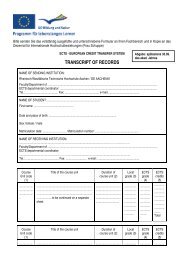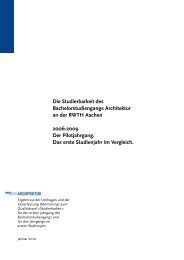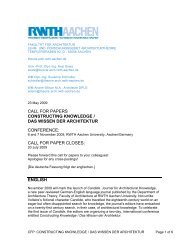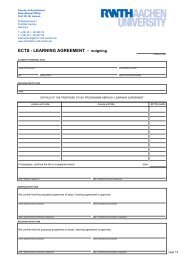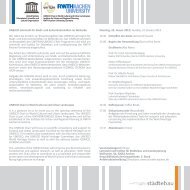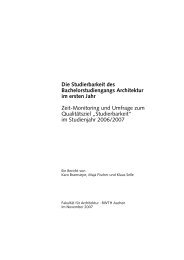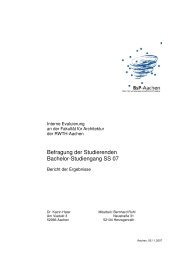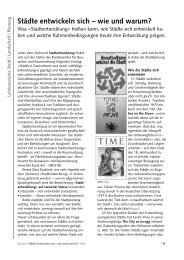Gutachten Dresden_englisch_dritte f.indd - Fakultät für Architektur ...
Gutachten Dresden_englisch_dritte f.indd - Fakultät für Architektur ...
Gutachten Dresden_englisch_dritte f.indd - Fakultät für Architektur ...
Create successful ePaper yourself
Turn your PDF publications into a flip-book with our unique Google optimized e-Paper software.
1.3 Structure of the study<br />
The study consists of several analyses. Each analysis builds on the findings of the others.<br />
a. Analysis of evaluation criteria<br />
(Chapter 2)<br />
This analysis examines the aspects that have contributed to the ICOMOS assessment<br />
of <strong>Dresden</strong>’s Elbe valley as a site worthy of World Heritage status, as well as the criteria<br />
that supported the inscription of the <strong>Dresden</strong> Elbe Valley on the UNESCO World<br />
Heritage List. The defined criteria form the basis for assessment of how the planned<br />
bridge will affect the site’s visual integrity.<br />
b. Analysis of the affected city and landscape areas<br />
(Chapter 3)<br />
This analysis examines in greater detail that section of the “<strong>Dresden</strong> Elbe Valley”<br />
UNESCO Word Heritage Site that is relevant to field-of-view analyses – the bend in<br />
the Elbe River between Albert Bridge and Loschwitz Bridge. The historical, natural and<br />
architectural qualities of the study area are examined. This analysis aims to capture<br />
those characteristic and special qualities of the Elbe river bend that demonstrate and<br />
validate its significance as a natural river landscape, as a natural area within the urban<br />
landscape, and as a historically evolved area of cultural activity displaying achievements<br />
in town planning, landscape gardening, architecture and engineering. The analysis also<br />
examines which locations have been established over time that facilitate the viewing<br />
and experiencing of the Elbe valley.<br />
c. Analysis of historical and current city- and landscape depictions of the <strong>Dresden</strong> Elbe<br />
Valley<br />
(Chapter 4)<br />
This analysis examines historical depictions of the city and landscape, supplemented by<br />
a brief overview of the most important postcard motifs and comments on images of<br />
<strong>Dresden</strong> used in the city’s promotional materials. The analysis aims to establish how the<br />
views of the <strong>Dresden</strong> city outline and environs, particularly those relating to the Elbe<br />
river bend, were developed by different artists over time, which landscape features were<br />
and are most characteristic in the artistic representations of the area, and which views<br />
and vantage points have played an important role.<br />
This chapter furthermore examines if the “classic” city and landscape views rooted<br />
in the public consciousness of the inhabitants of and visitors to <strong>Dresden</strong> and the<br />
7



